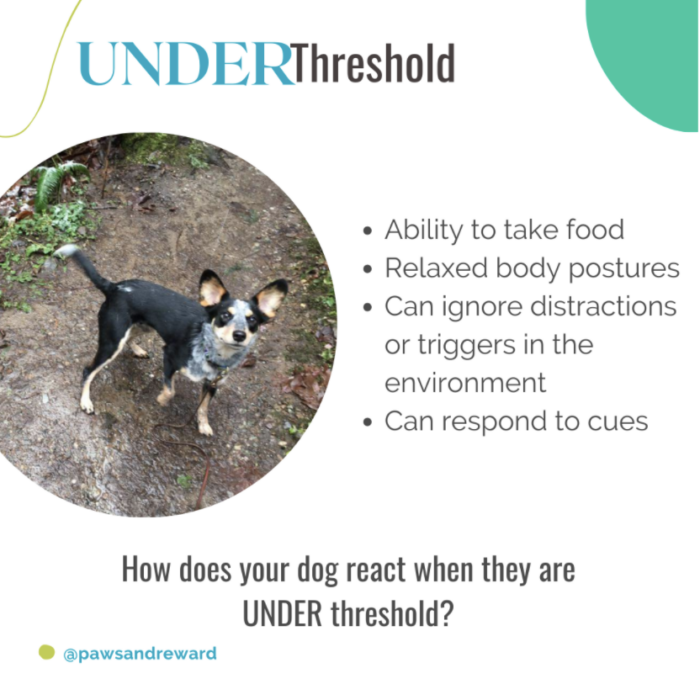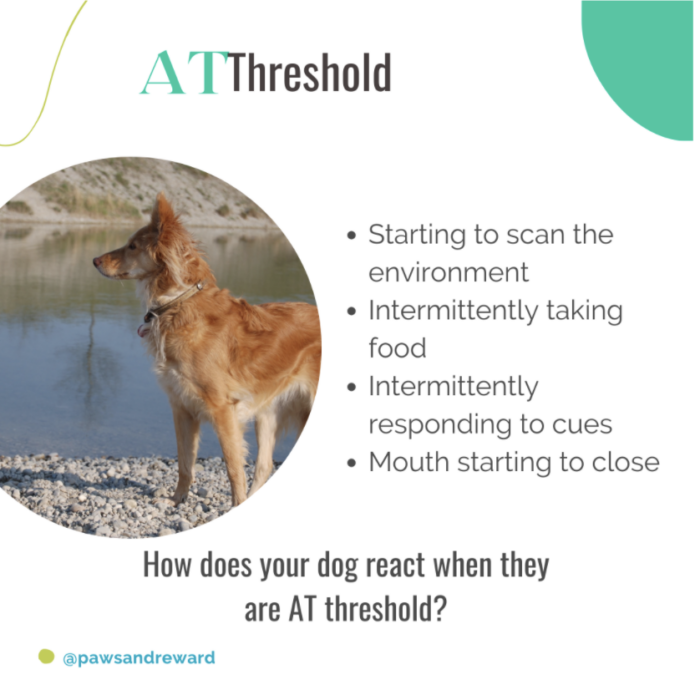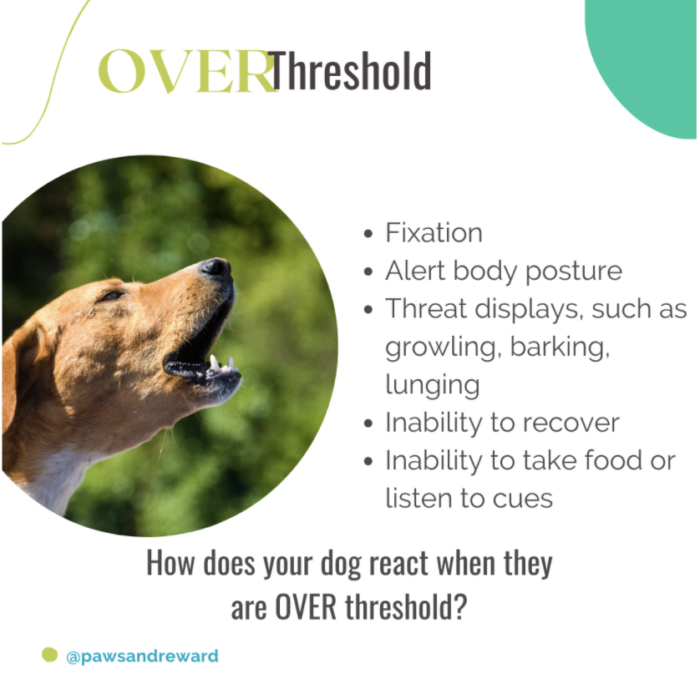I had the great opportunity to interview Sarah Stremming of the Cognitive Canine in Washington on this episode of the Paws & Reward Podcast about understanding a dog’s emotional threshold. Sarah is a dog trainer, agility and obedience competitor, and canine behavior consultant. She travels the globe helping dogs and handlers understand each other better. She also has a well-known podcast Cog-Dog Radio. Check it out!
In today’s episode, we discuss how to work with your dog’s emotional threshold during the training process. In order to make progress in our training plans, we have to push at our dog’s emotional edge in a safe way. But how far is too far when it comes to dog threshold training and how do you know when we have passed the dog’s threshold?
Understanding Your Dog’s Emotional Threshold & How It Relates to Dog Training
Sarah and I both subscribe to a least intrusive, minimally aversive approach (also known as LIMA dog training) when teaching both canines and their humans.
Least intrusive means allowing the animal to have choice and control over their outcomes. Minimally aversive means being aware of what the learner finds aversive throughout the training process and working to avoid these measures as best we can. This philosophy helps us create positive and safe environments for everyone in order to maximize the learning for both the dog and the human.
In contrast, there are many people that believe in the philosophy of pushing past a human’s or a dog’s emotional threshold as they “know” or assume the outcome will be okay. For example, leaving a child at school in hopes they see how fun it is, or letting a puppy cry it out at night in hopes that they will eventually tucker out and realize the crate is not that bad.
As LIMA dog trainers these examples make us cringe, since the fallout of pushing or flooding the learner can backfire (for example, refusing to go to school with increased temper tantrums from the toddler or fear and avoidance of the crate from the puppy).
However, sometimes we get lucky and that “push” does not have significant fallout and the child returns to school and the puppy enjoys the crate after all.
The challenge with always relying on pushing a dog’s emotional threshold to get the job done is that you are taking a big risk! One that I am not willing to take when working with my dog or my clients. Slow and steady wins the race.
So what is the emotional threshold definition, anyway?
The definition in human psychology of threshold is the lowest point at which a particular stimulus will cause a response in an organism. So how does this relate to a dog’s emotional threshold?
During our conversation, Sarah identified 3 separate areas of dog threshold we should pay attention to:
- Under emotional threshold: the dog does not react to the sight of the stimulus. He or she is either noticeably comfortable with the stimulus present or has a neutral response to the stimulus.

- At emotional threshold: the dog starts to notice the stimulus and shows signs of mild discomfort. This may include:
- Displacement behaviors (yawning, stretching, scratching, shaking off, sneezing, lip licking, sniffing)
- Starting to avoid the stimulus
- Looking or watching the stimulus
- Ear flicks to listen to the stimulus

- Over emotional threshold: the dog is very uncomfortable with the sight of the stimulus. This may include:
- Active avoidance, trying to create as much distance away from the stimulus as possible
- Staring at the stimulus, hard to redirect focus
- Barking, growling, lunging, or other threat display behaviors

Understanding a Dog’s Emotional Threshold During Training
The best way to notice if you have pushed too far past your dog’s emotional threshold in your training plan is to watch your dog’s body language and see which category they fall into: under, at, or over threshold.
The safest way to train includes teaching your dog a new skill while they are under threshold. This way the dog only has to focus on learning the task at hand (or paw!) and not the scary stimulus (the sight of another dog across the street).
Once the dog is fluent in the new skill (checking in with the handler) then we would start to push “at threshold” to see if we can help the dog learn this skill in the presence of the stimulus. We would do this in a gradual way in order to set the dog up for success.
For example, if my dog was consistently successful at doing check-ins while the other dog was 30 feet away, then I would push “at threshold” and move to 25 feet away from the other dog and try the same exercise at that distance. If I overestimated my dog’s ability at 25 feet and I pushed too far (and there are signs we’ve gone beyond the dog’s emotional threshold), then I would remove the dog from the situation in order to help him regulate and get back under threshold.
To learn more about emotional thresholds check out this post about trigger stacking and your dog’s threshold.
More Dog Training Resources You Can Use:
If you want to learn more about LIMA dog training and how you can work with your dog’s emotional threshold during training, be sure to check out The LIMA Beings, a collaboration with me and other positive dog trainers.
Need other tips to build your connection with your dog? Click here to explore our 6 Connection Principles and start applying them to your daily life with your pet.
The Podcast Sarah Mentioned On This Episode:
Cog-Dog Radio Podcast: Proofing with Chelsey Protulipac

